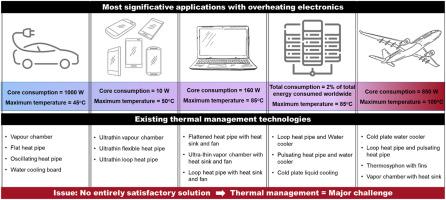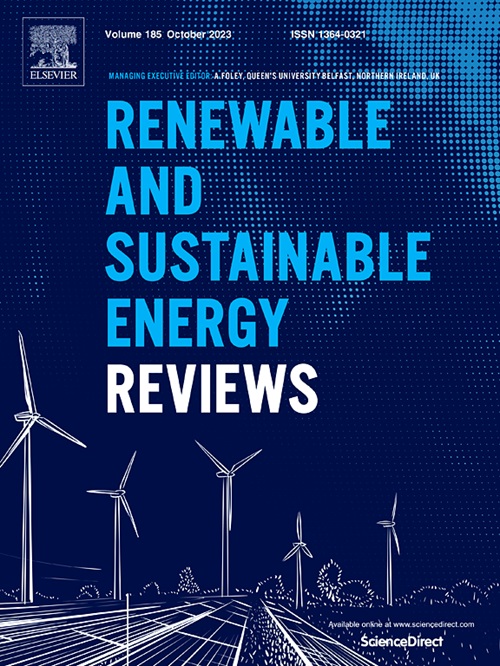电子设备和相变材料热管理回顾
IF 16.3
1区 工程技术
Q1 ENERGY & FUELS
引用次数: 0
摘要
有效的热管理系统(TMS)对计算机、数据中心和运输领域电子设备的最佳运行至关重要。本综述首先强调了 TMS 在当今电子设备中的重要作用,因为电子设备的性能、可靠性和能效至关重要。TMS 战略对于应对现代电子产品不断增长的计算需求所带来的热挑战至关重要。本研究侧重于关键应用:手机、笔记本电脑、数据中心、电动汽车和飞机。鉴于微电子技术的快速发展,电子产品的研究倾向于提高性能,从而对其热行为产生重大影响,但这一事实却很少引起人们的关注。设备故障主要发生在超过建议的温度阈值时。目前用于解决过热问题的冷却方案包括热管和/或热排水管(在大多数高效情况下,涉及液-气相变),并辅以嘈杂且耗能的风扇。尽管几十年来对这一问题进行了广泛研究,但仍未找到令人满意的解决方案,电子元件热管理仍是一项重大挑战。这项工作具有独创性,其结论是,基于混合材料(具有优化拓扑结构的金属基体,其微孔中浸渍有相变材料)的创新 TMS 的开发可为雄心勃勃的新一代微电子技术铺平道路。最高耐受温度阈值是目标应用的关键标准。审查根据潜热、无过冷却、与金属的兼容性等标准来选择 PCM。本文章由计算机程序翻译,如有差异,请以英文原文为准。

Review of thermal management of electronics and phase change materials
Effective thermal management systems (TMS) are crucial for the optimal operation of electronic devices in computing, data centers, and transportation. This review begins by highlighting the essential role that TMS plays in today's electronics, where performance, reliability, and energy efficiency are of utmost importance. TMS strategies are vital for addressing the escalating thermal challenges associated with the ever-increasing computational demands of modern electronics. This study focuses on pivotal applications: mobile phones, laptops, data centers, electric vehicles and aircraft. Given the fast evolution of microelectronics technologies, research in electronics tends to improve compacity, significantly impacting their thermal behavior, a fact that has garnered scant attention. Device failures mainly occur when recommended temperature thresholds are exceeded. Current cooling solutions used to tackle this overheating consist of heat pipes and/or thermal drains (in most efficient cases, liquid-gas phase changes are involved), comprising assisted by noisy and energy consuming fans. Although this problem has been studied extensively for decades, no satisfactory solution has been found, and electronic component thermal management continues to be a major challenge. This work is an original contribution, and concludes that the development of innovative TMS based on hybrid materials (a metallic matrix with an optimized topology and whose microporosity is impregnated with phase change materials) could pave the way for a brand new generation of ambitious microelectronics technologies. The maximum tolerable temperature thresholds constitute the critical criteria for the targeted applications. The review makes PCM selections based on criteria such as latent heat, absence of undercooling, compatibility with metals.
求助全文
通过发布文献求助,成功后即可免费获取论文全文。
去求助
来源期刊

Renewable and Sustainable Energy Reviews
工程技术-能源与燃料
CiteScore
31.20
自引率
5.70%
发文量
1055
审稿时长
62 days
期刊介绍:
The mission of Renewable and Sustainable Energy Reviews is to disseminate the most compelling and pertinent critical insights in renewable and sustainable energy, fostering collaboration among the research community, private sector, and policy and decision makers. The journal aims to exchange challenges, solutions, innovative concepts, and technologies, contributing to sustainable development, the transition to a low-carbon future, and the attainment of emissions targets outlined by the United Nations Framework Convention on Climate Change.
Renewable and Sustainable Energy Reviews publishes a diverse range of content, including review papers, original research, case studies, and analyses of new technologies, all featuring a substantial review component such as critique, comparison, or analysis. Introducing a distinctive paper type, Expert Insights, the journal presents commissioned mini-reviews authored by field leaders, addressing topics of significant interest. Case studies undergo consideration only if they showcase the work's applicability to other regions or contribute valuable insights to the broader field of renewable and sustainable energy. Notably, a bibliographic or literature review lacking critical analysis is deemed unsuitable for publication.
 求助内容:
求助内容: 应助结果提醒方式:
应助结果提醒方式:


